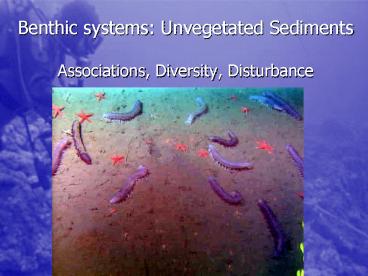Benthic systems: Unvegetated Sediments - PowerPoint PPT Presentation
1 / 30
Title:
Benthic systems: Unvegetated Sediments
Description:
Topography of a typical continental shelf. Characteristics of the habitat ... Higher turbulence than in deep ocean. More variable salinity and temperature ... – PowerPoint PPT presentation
Number of Views:82
Avg rating:3.0/5.0
Title: Benthic systems: Unvegetated Sediments
1
Benthic systems Unvegetated Sediments
- Associations, Diversity, Disturbance
2
Deep Sea Benthic diversity
- In on sediments
- Dominated by macrofauna
- Defined by size (gt 300 µm)
- Include polychaetes, molluscs, crustaceans,
echinoderms - Estimated to include between 500,000 and
10,000,000 species - Program to inventory under way (CeDAMar or
Census of Diversity of Marine Life)
3
Ecological importance of benthic macrofauna
- Nutrient cycling at ecosystem level
- Food resource for commercially important species
- Pollutant metabolism
- Dispersion burial
- Energy cycling
- Influence sediment structure turnover
4
Why so many species of macrofauna?
- Why would we expect low diversity?
- Apparently low variety of habitats so apparently
low number of different niches - Low rate of input for new energy/nutrients
- Competitive exclusion principle predicts low
diversity
5
What ecological mechanisms would explain high
diversity?
- H1 Niches are defined by more dimensions than
sediment type - Location within sediments (e.g., vary in O2)
- Other organisms create biotic variation
- H2 Competition is not a major factor
- Predator influence
- Disturbance influence
- H3 Local diversity may be low but regional
diversity can be high - This is multiplied by a very large area of habitat
6
Sediment variation Bioturbation
Variable sediment surface from biological
activity 1100 m
Box Core from 1900 m
7
Spatial variability in distribution of polychaetes
8
Continental Shelves overview
- 7.4 of ocean surface
- Average 78 km wide, 135 m deep
- Most above water during ice ages (18k bp)
9
Topography of a typical continental shelf
10
Characteristics of the habitat
- High productivity along continents
- Higher turbulence than in deep ocean
- More variable salinity and temperature
- Light penetration usually is reduced (often to 10
to 20 m)
11
Components
- Infauna classified by size
- Bacteria protozoa
- Macro- and meiofauna
- Major taxonomic groups
- Polychaetes, crustacea
- Echinoderms, molluscs
- In similar habitats, community composition
suggests convergence in form
12
Major questions
- What are the major components of communities in
unvegetated sediments? - What is the relationship between taxonomic
classification and ecological function?
(Functional equivalents) - How can disturbance promote diversity?
- What are the consequences of bottom-dredging
fishing techniques?
13
Functional groups examples of sediment
stabilizers and bioturbators
14
Parallel infaunal communities in North Temperate
oceans Ecological convergence
15
Apparent paradox high diversity, low habitat
heterogeneity
- Competitive exclusion is observed
- Deposit feeders exclude suspension feeders
(really amensalism) - Competition for space is documented
16
Why not have more competitive exclusion?
- More niches than we thought?
- Vertical sorting hypothesis
17
More niches?, continued
- Biotic facilitation
- Mutualism
- Commensalism (e.g., inquilines in tubes)
18
Can disturbance facilitate diversity?
- Sources of disturbance
- Biotic disturbance
- Burrowing, sediment processing
- predation (exclosure experiments)
- Water turbulence, wave action
- Human disturbance
- Beam trawls designed to scrape sediments a few
centimeters below surface - Otter trawls, etc. along surface
- Consider differences in scale
19
Effects of trawling on bottom structure
Fished Unfished
Kaiser Spencer. 1996. Journal of Ecology 65
348-358
20
Effects of local and mid-scale disturbance
- Very patchy distributions
- Leading to high species turnover in space
- Lower density than required for competitive
exclusion - Superior competitor is reduced before inferior
competitors disappear - Recolonization patterns add to diversity because
larval settlement depends on timing
21
Changes in community diversity with trawling
22
Why does disturbance from trawling reduce
diversity?
- Direct effects on habitat
- Scale of disturbance
- Disrupt biotic interactions
- Reduce potential for recolonization
23
(No Transcript)
24
(No Transcript)
25
(No Transcript)
26
(No Transcript)
27
(No Transcript)
28
Benthic processes deep ocean systems
29
Benthic processes coastal, subtidal systems
30
Benthic processes vegetated, subtidal systems































